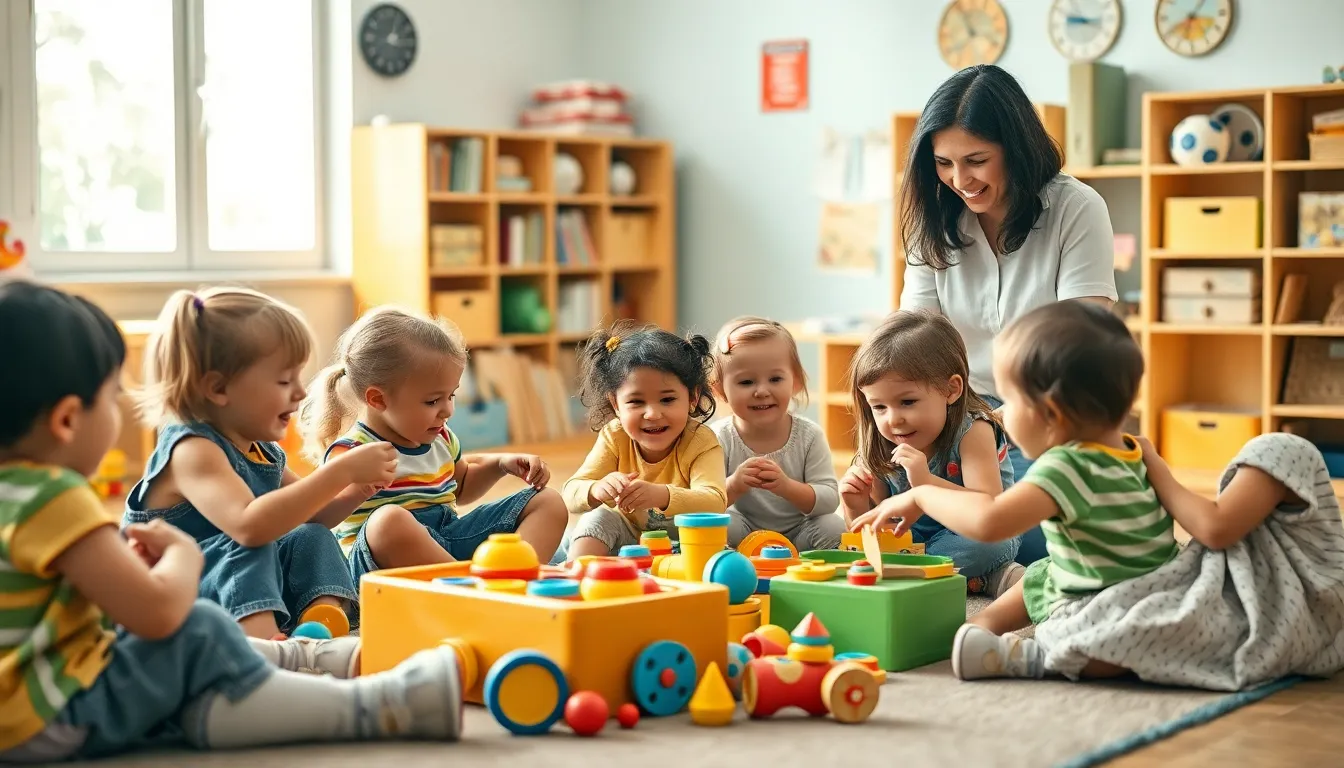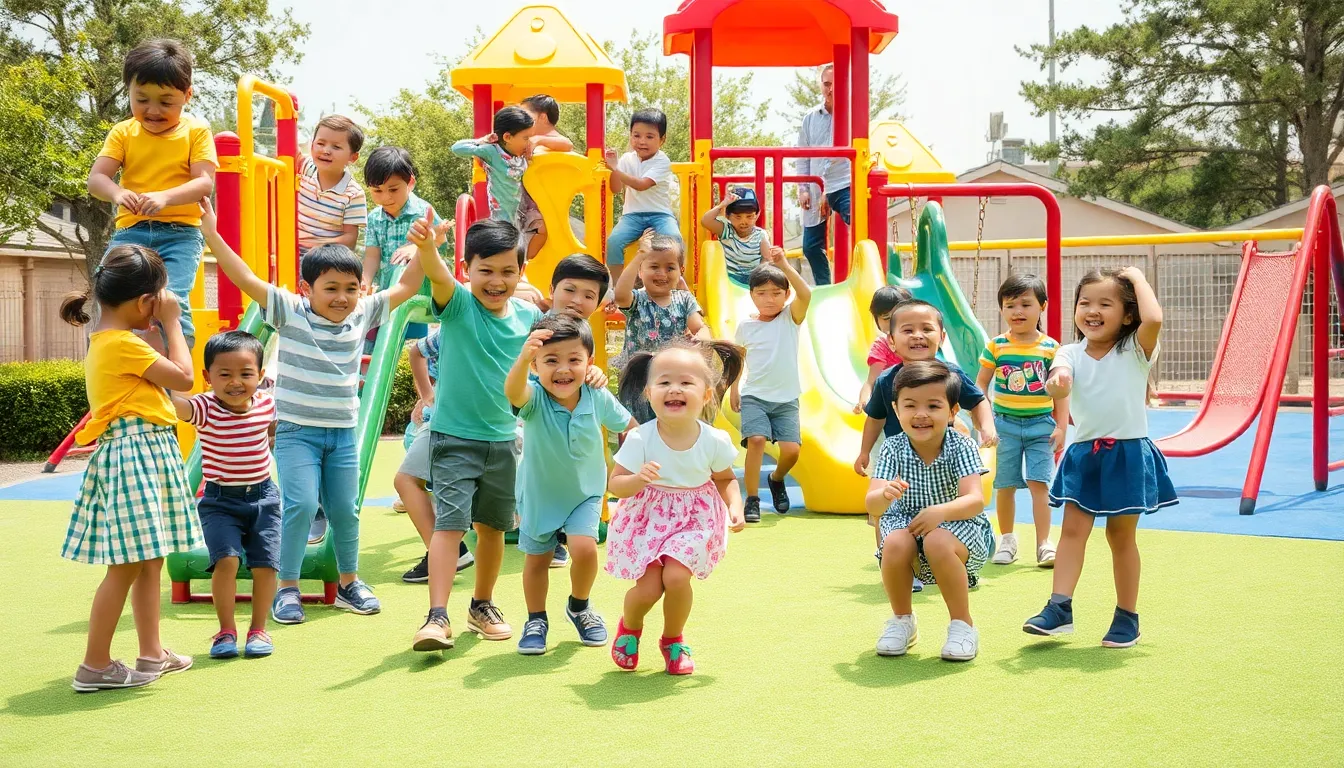Child development is like a roller coaster ride—full of ups, downs, and unexpected twists. From the moment a baby takes its first wobbly steps to the teenage years filled with eye rolls and questionable fashion choices, every stage is crucial. It’s not just about growing taller; it’s about building the foundation for a lifetime of learning, social skills, and maybe even a decent sense of humor.
Table of Contents
ToggleUnderstanding Child Development
Child development encompasses the physical, emotional, social, and cognitive growth experienced from birth to adolescence. This dynamic process involves several stages that lay the groundwork for future skills and behaviors.
Stages of Child Development
Growth occurs in distinct stages, including infancy, early childhood, middle childhood, and adolescence. Infants develop motor skills and sensory perception, marked by milestones such as crawling and walking. Early childhood focuses on language acquisition and social interactions, characterized by the development of friendships. Middle childhood emphasizes critical thinking and emotional regulation, as children refine their understanding of the world. Adolescents face identity formation and increased independence, navigating complex social dynamics.
Importance of Early Years
The early years serve as a critical period for cognitive and emotional development. Research indicates that 90 percent of brain growth occurs by age five, underscoring the significance of stimulating environments. These formative years influence lifelong learning abilities and social skills. Engaging with caregivers, stimulating play, and providing educational opportunities during this time fosters resilience and adaptability. Active participation in these early experiences builds a foundation for future success in school and relationships.
Factors Influencing Child Development

Numerous factors impact child development, shaping physical, emotional, social, and cognitive growth. Understanding these elements provides insight into creating supportive environments for children.
Genetics and Environment
Genetics plays a crucial role in child development, as inherited traits influence physical characteristics and potential abilities. While genetic predispositions establish a foundation, environmental factors significantly affect how these traits manifest. Exposure to nurturing caregivers helps children thrive, fostering resilience and adaptability. Stimulation through play and learning opportunities enhances brain development, particularly in early years. Environments rich in language, interaction, and encouragement lead to improved cognitive abilities and social skills. Research indicates that an interactive atmosphere positively shapes a child’s development trajectory.
Socioeconomic Status
Socioeconomic status significantly influences a child’s access to resources. Families with higher socioeconomic status often provide better educational opportunities, healthcare, and nutritious food. Such access leads to improved cognitive outcomes and overall wellbeing. Conversely, children from lower socioeconomic backgrounds may face challenges, such as limited access to quality education and healthcare. These stressors can hinder development, affecting emotional and social growth. Studies demonstrate that children in supportive, resource-rich environments exhibit higher academic achievements and healthier social interactions. Thus, socioeconomic factors play a pivotal role in shaping a child’s developmental journey.
Milestones in Child Development
Tracking milestones in child development provides valuable insights into a child’s growth journey. Each stage presents unique indicators of progress in physical, cognitive, and social-emotional realms.
Physical Development Milestones
Physical development milestones encompass key motor skills and coordination. By six months, many babies can sit with support while some might even push themselves up. Around twelve months, children often take their first steps. Progress continues, with two-year-olds typically running and climbing. By age three, kids can kick a ball and jump with both feet. These developmental markers highlight the importance of physical activity and a safe environment to explore.
Cognitive Development Milestones
Cognitive development milestones signify advancements in thinking and problem-solving. At two years, children often recognize names of familiar objects. By three years, many can engage in simple pretend play, showcasing imagination. Observations show that four-year-olds can follow multi-step instructions. By age five, most children understand basic concepts of time and can count to ten. Stimulation through books and educational games enhances these cognitive skills.
Social and Emotional Development Milestones
Social and emotional development milestones reflect a child’s ability to interact and express feelings. By age two, toddlers start to show preferences for particular friends and toys. Around three years, they begin to understand sharing but may still struggle with it. By age four, children often engage in cooperative play with peers. By five, most can express a range of emotions and recognize feelings in others. These milestones emphasize the role of nurturing relationships in fostering emotional intelligence.
Challenges in Child Development
Numerous challenges can hinder optimal child development. Understanding these obstacles provides insight into improving outcomes for children.
Developmental Delays
Developmental delays can occur in various areas such as speech, motor skills, and cognitive function. Children exhibiting delays may take longer to meet milestones associated with their age. For instance, if a child doesn’t walk by 15 months or show language skills by 24 months, early intervention can greatly enhance their progress. Research suggests that approximately 1 in 6 children experiences a developmental delay. Timely evaluation and support from healthcare professionals and educators promote better long-term outcomes for these children.
Behavioral Issues
Behavioral issues often arise during child development and can significantly impact social interactions. Common examples include attention deficit hyperactivity disorder, anxiety, and oppositional defiance disorder. Children may exhibit difficulty focusing or follow instructions, leading to challenges in academic settings. It’s important to recognize that these behaviors might stem from underlying emotional or cognitive issues. Studies show that 5 to 10 percent of children experience significant behavioral problems. Parents and caregivers play a crucial role in identifying these behaviors early, allowing for timely strategies and interventions that foster healthier development.
Strategies to Support Child Development
Supporting child development involves implementing strategies that cater to various aspects of growth. Fostering positive environments and engaging techniques plays a vital role in this process.
Positive Parenting Techniques
Positive parenting techniques emphasize nurturing and responsive interactions. Encouragement reinforces a child’s self-esteem, while consistent routines provide a sense of security. Active listening allows caregivers to understand a child’s needs and emotions better. Celebrating small accomplishments builds motivation and confidence. Offering age-appropriate choices fosters independence and decision-making skills. Using positive reinforcement can effectively guide behavior, ensuring that children feel valued and respected in their development journey.
Educational Approaches
Educational approaches create a foundation for cognitive growth. Engaging activities stimulate curiosity and critical thinking. Incorporating play-based learning allows for exploration and creativity while enhancing problem-solving skills. Structured reading time supports language development, with varied materials catering to different interests. Hands-on experiences, such as science experiments, promote active learning and exploration. Collaborating with parents to reinforce classroom concepts further strengthens a child’s understanding and application of knowledge.
Child development is a complex journey filled with critical milestones that shape a child’s future. The interplay of genetics and environment plays a significant role in determining how children grow and thrive. Early experiences and nurturing relationships are vital for fostering resilience and adaptability.
Recognizing the challenges that can arise, such as developmental delays or behavioral issues, allows caregivers to implement timely interventions. By creating supportive and stimulating environments, parents and educators can significantly enhance a child’s cognitive and emotional growth.
Ultimately, investing in a child’s development during these formative years lays the groundwork for lifelong success in learning and relationships.




